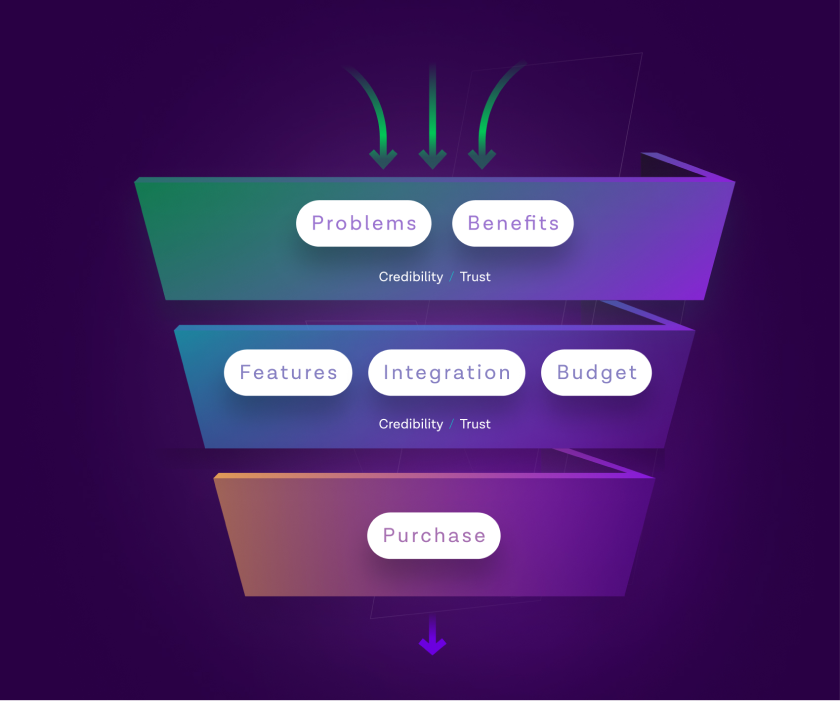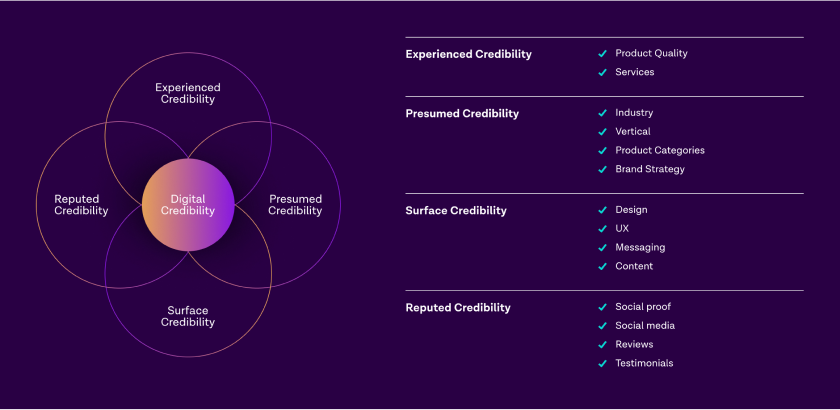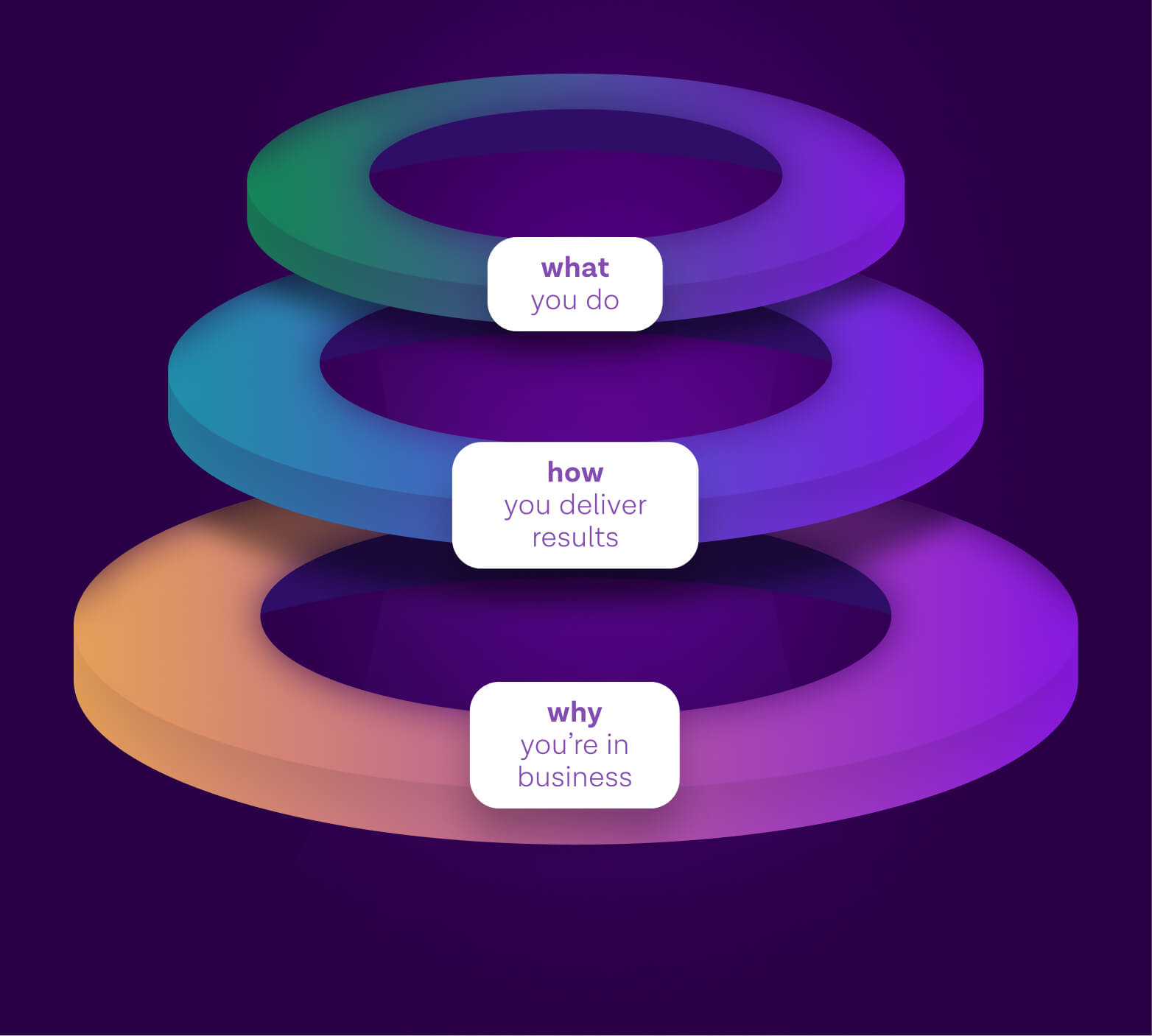
Credibility creates trust. Trust drives action.
But many high-growth companies can often be singularly focused on their product and technology–they leave brand credibility as an afterthought. And no matter what you say about your product —if your brand isn’t credible — you will not be considered.
Forward-thinking companies make smart investments to protect their brand credibility because the stakes are high.Studies show that visitors to your website can make a decision whether to stay or leave in just 50 milliseconds (50ms).

They’re not making that decision in the blink of an eye.
They’re making the decision in ⅓ the blink of an eye.
Certainly, no small part of that lightning-quick decision-making process is powered by the perception of credibility that’s displayed (or not displayed) on the site.
Of course, we also know that purchase decisions are also driven by credibility. Consumer research has found that improved confidence is correlated with nearly a 50% increase in purchasing behavior.
These findings apply equally for companies selling clothing and companies selling $1 million tech infrastructure.
In other words, credibility shapes perception and drives revenue.
Here’s where many tech companies are falling short on their brand.
The Brand Credibility Gap
Credibility is valuable specifically because it’s difficult to fake.
When you have credibility, it signals to potential customers that you’re trustworthy but also that you’re stable, reliable, and predictable (safe choice).
Having a credible brand means your customers know what to expect and expect to receive what they need. Your brand needs to convey that you know their pain point inside and out, and that when they call you, that pain goes away.
Especially for startups and growing tech companies looking to sell into enterprise accounts, your brand’s reputation will be under heavy scrutiny. And for good reason, with 90% of technology companies ultimately failing.
The Fortune-500 customer you want to sign a 3-year contract needs to know how long you’ll be around and that you won’t radically pivot in the next 2 weeks.
You know you have a credibility issue when your sales team hears questions like:
- Which companies have you worked with?
- Do you have experience in MY specific industry?
- When did you raise funding last?
- How much have you raised?
This is called the Credibility Gap, and it’s the responsibility of marketers to overcome.

Your job as a marketing leader is to identify when, where, and how customers are assessing your credibility and then being proactive, deliberate, and strategic about how you build brand trust across your marketing mix.
So how do you know if you’re doing it right?
The story, design, and technology of your website send strong signals about your brand’s credibility.
It’s where most prospective customers first interact with your company, or it’s the first place they look for more information after they’ve learned about your products.
But before we look at exactly how your brand can be damaging your credibility, let’s start by unpacking how we – as humans and as customers – perceive credibility.
A Framework for Understanding Digital Credibility
Let’s look at the core components of trust. Then we can see what levers and strategies should be part of our playbook for creating trust and closing the Credibility Gap.

A seminal study from Stanford’s Persuasive Technology Lab found that credibility–specifically in the digital space–is constructed of four key components.
- Presumed credibility – Industry, verical, product categories, and brand strategy
- Reputed credibility – Social proof, social media, reviews, testimonials
- Surface credibility – Design, UX, messaging, content
- Experienced credibility – Product quality, service
Looking at each facet, we can understand both the role of brand credibility in the buyer’s journey and which strategies and channels are related to each.
Being Strategic About Building Trust with your Website
Nearly every company’s website experiences some of these challenges.
But, these problems don’t happen in a vacuum and they’re not tactical hiccups that you can fix in a day by adding a logo bar to your site.
The brand credibility problem is the product of a broken process for designing and building websites that doesn’t consider credibility at a strategic level.
At eight25, our playbook is built around strategy. As a central part of that strategy, we assess, understand, and build brand credibility into our entire process, from storytelling to design to technology.
There are four key steps in our process that help us align around building credibility and reinforcing the brand narrative as a central piece of the website strategy.
Identify the gaps
Credibility is cultivated through consistency.
If your messaging and positioning are inconsistent or don’t align with how you’re already perceived by potential customers, then you create confusion.

During our discovery process, we dig deep into understanding your ideal positioning–the perception that you want to exist–and the gaps that exist in both your current marketing strategy and in conversations you’re having with potential customers.
This helps us define clear gaps in your strategy that we can address in our messaging hierarchy.
2. Align the messaging hierarchy
Once we understand the gaps, we can develop a framework to address those inconsistencies.
We build a unified communication and messaging strategy that’s rooted in the brand strategy and aligns your business with your buyers.

This helps us close the gap and make sure that all of our key communications and key messages are anchored by the overall brand and business strategy.
3. Mapping the page-level journey
Before we delve into wireframing and design, we want to overlay the messaging strategy that we developed above with the specific pages on the website.
Starting with a single page – like the homepage – we use our messaging hierarchy to construct a journey that informs how the content itself should be structured.
4. Define the site-level journey
Finally, we create a Journey Deck.
This resource extrapolates our messaging strategy across the customer journey to encompass all of the relevant pages on your site, building a framework for how your ideal customer profiles will move through the site and how we will build and maintain credibility.

Using this framework, we can identify opportunities to bridge the Credibility Gap using strategic elements like social proof, case studies, and content that establishes your brand as a thought leader.
Maximizing Brand Credibility in your Website
For over 10 years, we’ve been honing and crafting our playbook. We’ve looked at traditional approaches to site design and developed a modern, smarter approach to driving business results.
A high-quality website is table stakes. But not all sites are built equally.
A strategic website delivers results:
- 40% increase in revenue
- 37% drop in bounce rate
- 81% traffic increase year-over-year
- 2x conversions
We understand your brand’s credibility is hard-won and fragile. We know what’s at stake. We understand that CMOs (marketing leaders) live and die by brand credibility.
That’s why we use proven frameworks to protect–and improve–one of your most critical business assets.


